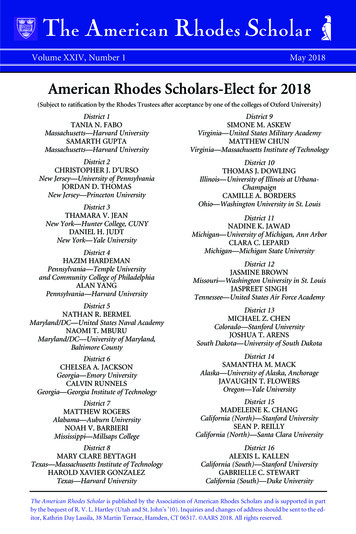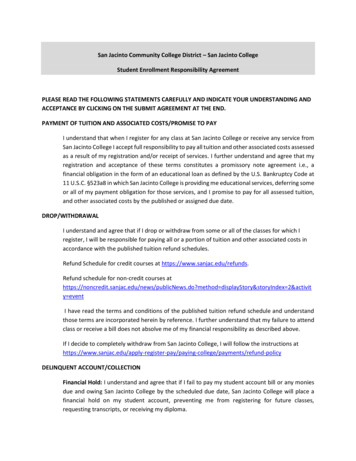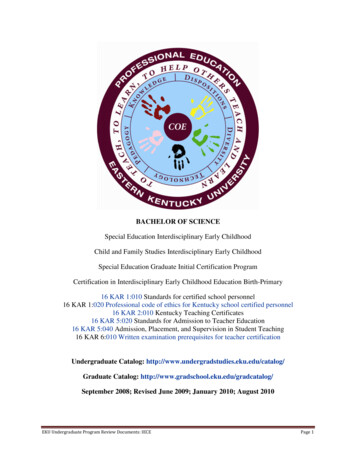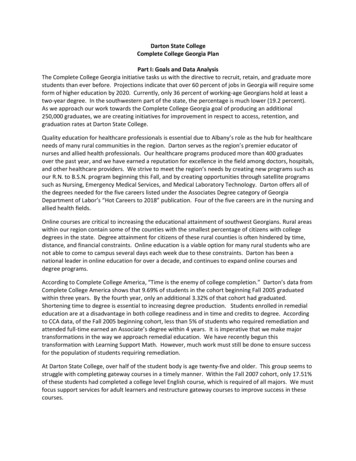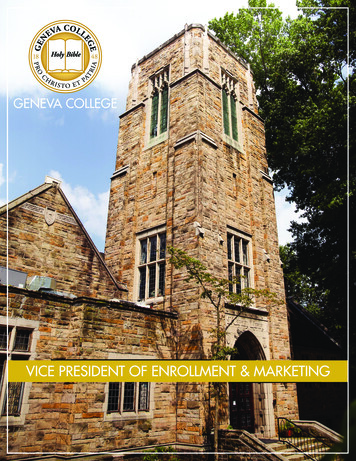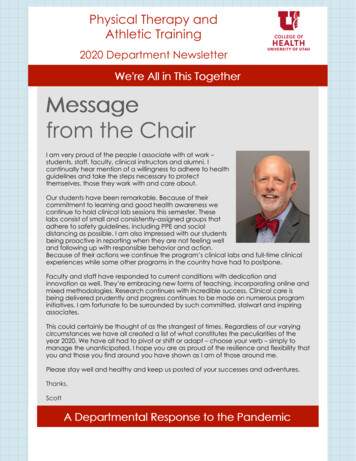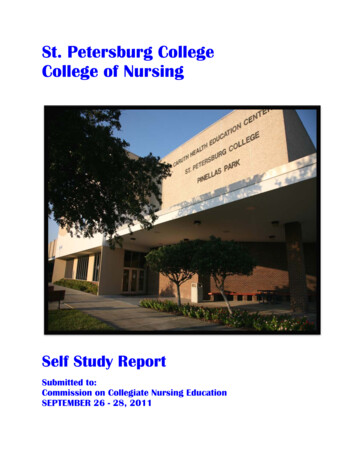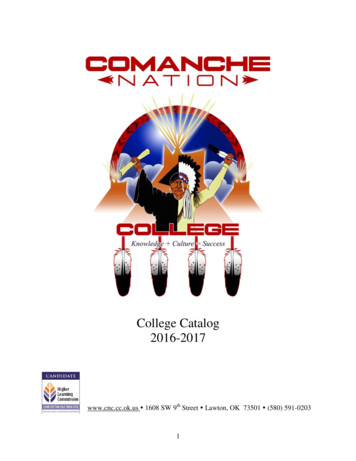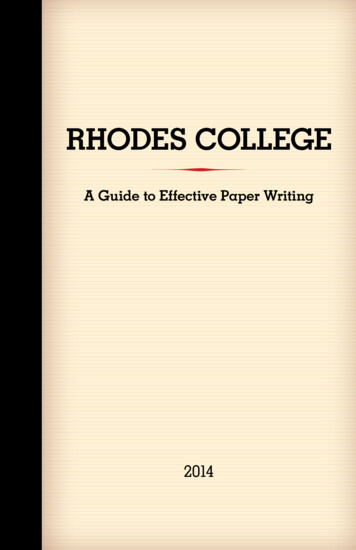
Transcription
RHODES COLLEGE A Guide to Effective Paper Writing2014
CONTENTSINTRODUCTIONI. THE WRITING PROCESSA. Planning31. Brainstorming 32. Researching 53. Outlining 9B. Writing111. The Thesis Statement122. Introduction 143. Body Paragraphs 154. Conclusion 20C. R evising201. Editing for Content and Argument212. Editing for Clarity and Style223. Proofreading 244. Formatting 255. Citing 26a. MLA27b. Chicago Style32II. INTELLECTUAL HONESTYA. To Cite or Not to Cite?351. Uncited 352. Cited 36B. When to Quote and When to Paraphrase371. Quote 372. Paraphrase 37C. The Honor Code40III. GRAMMAR AND PUNCTUATIONA. Sentence Structure411. Clauses 412. Sentence Fragments 41
3. Run-On Sentences 424. Parallelism 425. Dangling or Misplaced Modifiers43B. Verbs441. Subject-Verb Agreement 442. Verb Tense 453. Passive and Active Voice45C. L anguage461. That versus Which 462. Prepositions 483. Apostrophes and Contractions484. Pronouns 49D. Punctuation501. Colons 502. Semicolons 503. Commas 50IV. WRITING ETIQUETTEA. Papers521. Final Draft 522. Late Papers 523. Paper Grades 524. Backup Copies 53B. Emails531. Appropriateness 532. Pitfalls 54V. ADDITIONAL RESOURCESA. CitationB. Grammar and PunctuationC. Online Writing L abs & R esourcesD. PlagiarismE. Writing Process5556565657Appendix. SHORTHAND SYMBOLS 58(Clicking on an item in the table of contents links to that specific section of this guide)
INTRODUCTION For many students, the prospect of paper writing is daunting,dreaded, and, above all, frustrating. Sometimes it is hard to knowwhere to start; sometimes the problem is with what has already beenwritten; often it is the process in between. Instead of simply givinggrammar instruction, this guide offers advice for every stage ofwriting an academic paper and will take you through the process ofconceiving an essay subject, refining a thesis, researching evidence,developing an argument through analysis, clarifying your prose,and finally revising and proofreading your paper. The guide alsoprovides useful information about correct documentation, grammarand punctuation, and writing etiquette.This guide is not meant to replace the instruction of your professors,but rather to supplement it. Many of the suggestions and descriptionsregarding writing have come from the Rhodes Writing Centerdirector and tutors, English Department writing professors, andfaculty and staff from across the college. When using this guide,please remember that it may not address every nuance of writing inevery discipline; you should consult with your professor for questionsthat are not answered here.You may also seek assistance with your writing at the Writing Centerlocated in 122 Barret Library. In 30-minute sessions, trained tutorswill help you at any stage of the writing process: brainstormingideas, narrowing your topic, forming a thesis, outlining, reorganizing paragraphs, revising a draft, or even understandingprofessor feedback on a graded paper. To set up an appointment,go to: www.rhodes.edu/writingcenter/9039.aspUltimately, what both the Writing Center and this guide will helpyou with is seeing the relationship between your writing process andthe resulting product, which is the paper that others—presumablyyour professor—will read. Essentially, every writer begins to write1
according to his or her own process (some must have an outline,others dive right into the prose, and so on), but at some point thatprocess must take shape for the reader. This guide will help youmove through those stages.2
I. THE WRITING PROCESS The art of paper writing is generally a three-step process comprisedof planning, writing, and revising. The planning stage includes askingand answering a lot of questions about your subject; the writing stageputs those answers into a developed argument; and the revising stageinvolves refining your thesis, possibly restructuring your paper, andproofreading.A. Planning1. BrainstormingBefore you begin to write, carefully read your assignment, payingspecial attention to identifying exactly what the professor has askedyou to produce. Each type of paper has a specific goal to accomplish.For example, a history paper that compares the Battle of Bull Runwith the Battle of Gettysburg seeks to sort out the similarities anddifferences between two events; an international studies paper thatapplies the realist theory of international relations to the contextof the Cold War seeks to support a given theory through historicalevidence. The topics and research you need to consider largely dependon what kind of paper you are writing. Therefore, the first step towriting a well-organized essay is to identify the type of essay you areassigned to write and plan your essay according to the guidelinesgiven by your professor. To set up an appointment, go to:www.rhodes.edu/writingcenter/9039.aspA typical problem students have with their writing assignment isselecting a subject (or argument about that subject) that is too broadto cover in the space of a single paper. The unfortunate result is apaper weighed down by generalizations, assumptions, and summary.When considering your subject, be sure to locate your own particularargumentative niche so that your paper will be a focused, thoroughlyconsidered analysis and will be supported by ample, specific evidence.3
Below is a series of questions to help you begin this process ofnarrowing your subject, conceiving of your argument, determiningyour evidence, and envisioning a structure for your paper.Subject: What are you going to write about? Is there a specific topic assigned for the paper? Do you have freereign to interpret the subject as you want or has the professorasked for particular information in the paper? What about the subject interests you? How can you narrow orinterpret the subject in a way that suits your interests? What discussions from class about this subject were mostprovocative? What have you underlined in your text or takennotes on in class with regards to the subject? Do you see anytrends?Purpose: What is the purpose or goal of the paper? Is it meant to persuade? Inform? Compare? Assess? Is the paper supposed to include outside sources? Is it meant to reach beyond class discussions and course texts? Areyou being asked to reiterate a course idea or to expand on it? Are you required to answer specific questions?Argument: What will your argument be? What has your professor or someone else said about this subjectthat you disagree with or find puzzling? What is the most profound question you have about the subject?How can you turn that question into an argument: a thesis? What do you need to do (revisit, read, research) to help youestablish a position about the subject?Evidence: What type of evidence do you need to support the argument you willmake about the subject? Will you use only your own analysis? Or do you need to do anyresearch? Are you being asked to incorporate others’ critical ideas aboutthe subject? Where do you find this sort of information?4
What kind of documentation is required? MLA? Chicago Style?APA?Organization: What is the best way to organize your ideas? Can you group together any of your ideas about the subject? Canyou divide the subject into categories or “sub” subjects? Does one idea naturally follow another? Is one idea contingent onanother? Do you want your reader to understand certain pointsbefore others? Are some points more important than others? If there is an assigned length, how will that affect your priorities?As you answer these questions, you should keep the suggested essaylength in mind. A ten-page research project requires lengthier topicsand significantly more factual support than, for example, a threepage literary analysis. A well-organized paper uses the assignedspace effectively; you should plan for and gather enough topicalinformation to adequately complete the assignment and support thethesis before your writing begins. As a rule of thumb, a double-spacedpage with one inch margins and 12-point text has approximately 300words. With this in mind, you can generally conclude that a 1500word assignment is about five typed pages and can plan your essayaccordingly.TIP: One productive way of brainstorming and asking andanswering questions is to sit down with a peer, whether a friend or atutor at the Writing Center, and have a 30-minute conversation aboutyour ideas. Your professors are often happy to meet with you, too,to discuss your ideas about the paper. Be prepared, though, to takenotes; in other words, bring a pen and paper.2. ResearchingIf your assignment requires outside sources for evidence, you haveone more step before you can begin outlining and then drafting.Researching can be intimidating, especially if you are having troublefiguring out what information you need and where to get it. Below5
are some suggestions to get you started.Research QuestionsThe first step in beginning research is to come up with researchquestions that you need to answer in order to prove your argument.The answers will be the evidence for your paper. At this stage,you might also consider adding possible sources for finding theinformation. For example, if you are arguing that—despite commonassumptions that the Harry Potter series has increased readingfrequency among adolescents—children today are still reading onlyas much as they did ten years ago, you might include the followingquestions (Q) and source (S) ideas: Q: How many adolescents read books before Harry Potter?S: Reference materials for the Literacy Council; history ofadolescent book purchasing, library records.Q: How many adolescents read books today? S: Same sources asabove but for current year.Q: What changes in education have occurred in the last tenyears that might have affected reading habits? S: Department ofEducation curriculum and/or reading initiatives.Q: Are there any social or cultural changes that might haveaffected reading habits? S: Surveys on adolescent activities,behavior.Search WordsMost students know what search words are and most can come upwith an initial list of obvious search words for a topic. In the exampleof Harry Potter, the search words that come to mind immediatelyare Harry Potter, JK Rowling, reading, adolescent, reading rates, and eventhe individual book titles. However, if you restrict yourself to justthese obvious words, your search will not yield enough results tobuild a formal paper and thoroughly prove your thesis. You muststretch your thinking to come up with additional terms for yoursearch. For example, try adding these words to your list: teen, pre-teen,literacy, behavior, books, kids, children, phenomenon, trends, literature, juvenile,6
media, television, Scholastic (publisher of HP books), libraries, motivation,education. By combining some of these terms, your searches will yieldfar more “hits” and potentially more interesting, certainly moreproductive, results.Online DatabasesThe Barret Library website includes a comprehensive listing ofonline databases accessible through the library’s pages. The collegepays for subscriptions to these databases and their use is limited tocurrent Rhodes students and staff. To access a database from oncampus, you must be logged into a computer. To access one fromoff-campus, simply click on the database link from the RhodesOnline Database page, and you will be prompted for your Rhodesusername and password.Your first stop for research should be www.rhodes.edu/barret. Onthis page, you will find numerous options; the most popular link forperusing online databases is in the left box: click on the highlightedword “databases,” which will take you to an extensive description ofonline databases and resources. Most of these databases are particularto specific fields or topics, such as psychology or “Civil War,” butsome encompass larger categories like “the Humanities” and someare purely reference sources like the Oxford English Dictionary. Byclicking on the “more info” button, you can find out what kind ofinformation the database offers. In most cases, a non-reference typedatabase will ask for your search terms and then provide a bibliographyof articles and (less often) books that include information about yoursubject. Be prepared to spend a good deal of time with the “OnlineDatabases” website: this part of researching can be laborious becauseyou will undoubtedly uncover many sources that you do not need,and weeding through the vastness of information can be tedious.However, if your goal is to produce “outside” evidence for yourpaper’s argument, it is a necessary process.Scholarly ArticlesIt isn’t hard to figure out what constitutes a newspaper article or7
a survey, but determining what qualifies as a scholarly article canbe difficult. At some point at Rhodes, you will be required to usescholarly or “critical” articles in a paper and you should be preparedby knowing what that means. A piece of scholarship is very differentfrom any other kind of resource. In the simplest terms, it is a textwritten by a scholar, reviewed and ultimately approved by scholars, and publishedby a scholarly source. You must confirm these aspects of an articlebefore you can consider it scholarly. The easiest way to determine thescholarliness of an article is to search for it in a database that coversonly scholarly journals. These journals have an editorial board ofexperts in the field to review and approve the articles contained ineach publication, including online editions. You might also consultthe database “MLA Bibliography of Periodicals” and find the entryfor the journal in which the article is published. This entry will tellyou whether or not a journal is “peer-reviewed,” which is anotherway of identifying scholarly work. You should consult with yourprofessor for a list of databases or journals that are relevant in thefield of your course study.Internet SourcesBe wary of using the World Wide Web as a source for an academicpaper’s evidence. Although the internet provides a constant streamof information, it is often impossible to know where that informationcame from and whether or not it is accurate. It is especially dangerousto use the web for “scholarly” information. For example, if you areresearching the effects of living near a particular chemical plant,you probably can find quite a bit of commentary on the web. You’lldiscover local newspaper articles debating the issue; you’ll see theplant’s own public relations announcements; you might even findblogs written by people living near the plant. Although some of thisinformation might be anecdotally relevant to your topic, none ofit can be considered scholarly evidence. It is simply commentary,probably from biased parties.8
TIP: When you are compiling your evidence from an outside source,be sure either to print the actual text or to copy it verbatim—inquotation marks—so that you always have a record of the original.Students have been known to paraphrase a source text only toparaphrase again in the course of writing their paper and end up witha version that is too similar to the original. It is not worth the risk ofbeing accused of an honor violation. You can find more informationabout quoting and paraphrasing in the next chapter: II. IntellectualHonesty.3. OutliningOnce you have considered these “planning” questions, begunresearching (if necessary), and established your basic argumentor hypothesis, you should create an outline, which serves as thetransition between your ideas and your draft and is basically adirectional map—a step-by-step guide through the essay. Youshould write down your outline, even if it is informal; you mighthave only a “working title,” a thesis statement, and one descriptivesentence for each body paragraph. Also at this stage of the planningprocess, you should remember to document any quotations or datafrom your texts or research that you intend to use in your draft. Besure to include correct citations with your notes to avoid unintendedplagiarism. For a more comprehensive and useful outline, follow thesteps below.Developing your ArgumentTo begin, determine the main points that support your thesis. Mainpoints are essentially claims that will develop your larger argument.In “report” type papers, these points are topic sentences. A wellconceived thesis should direct you towards the nature, order, andrelative value of your main points. (You can find more informationabout writing a thesis in the next chapter.) Not every claim will be ofequal value, and some may need to come before or after others or beprivileged in a particular way. These main points will constitute theRoman numerals in your outline.9
Determining EvidenceEach main point or claim needs to be supported by evidence andanalysis that essentially connects the evidence to the claim. For thesake of an outline, you should list pieces of evidence under theircorresponding point and identify where to locate that evidence later(i.e., page number, source). If you encounter evidence contrary toyour main points, you should determine how you can undermine thatevidence, thus weakening a potential counter argument. Each pieceof evidence can be listed with a capital letter under its correspondingRoman numeral “claim.”Organizing your IdeasOnce you have categorized your supporting points and evidenceinto an outline, you should check the format of your outline. Awell-organized outline is logical and consistent and follows—from beginning to end—an understandable route, with one pointbuilding on the previous one or adding a new, but appropriate, idea.For example, if an outline for a history essay begins in chronologicalorder, it must carry this logical format through to the end.Documenting your SourcesEven at this stage of the writing process, you should remember todocument any quotations or data from your texts or research thatyou intend to use in your draft. If you include correct citations at thispoint, you are less likely to forget or mis-cite a source in your finaldraft. Plus, you will have any easier time locating that informationwhen you need it for your draft.Moving from Outline to DraftIf you have carefully organized your outline, it will be much easierto expand it into a successful paper. Each main point in your outlinewill become a topic sentence or claim statement in your paper. Atopic sentence is generally the first sentence in a paragraph thatstates the point (the topic) of that paragraph, and while it shouldcreate a transition from the previous paragraph, it should not justrepeat or reword the last sentence of that paragraph. Paragraphs10
that lack topic sentences are confusing, unfocused, even distracting.Each topic sentence should in some way relate to your thesis; that is,each topic sentence needs to support your thesis the way each mainpoint supported the thesis in your outline. Your supporting points(evidence) in your outline will be used to write supporting sentencesin your paragraphs. With a clear topic sentence and well-craftedsupporting sentences drawn from your outline, each paragraphshould be unified and focused on one main topic.TIP: If you are really stuck even after answering the planningquestions or if outlining has been unsuccessful, you might try freewriting, an exercise developed by Peter Elbow in his book Writingwithout Teachers (Oxford: UP, 1998). In free writing, you write non-stopfor about ten minutes on anything about your subject that comes tomind. During this time, you do not lift your pen from your paperor your fingers from the keyboard. You do not worry about sentencefragments, correct grammar, word choice, spelling, or coherency.You do not re-read as you write. You simply write. At the end of theten minutes, you take from your writing sample whatever good ideas,phrases, and sentences you can and try again. Repeat the processagain and again until you have something you can use for your paper.It may take several runs to get a few sentences worth keeping, but itdefinitely helps get past writer’s block.B. WritingOne of the most common mistakes that students make when paperwriting is to put it off until the last minute; thus, there is rarely timeto create a draft. First drafts can be particularly useful in that theyallow for a stream of ideas while subsequent editing prevents theseideas from being disorganized or unclear. When you write a draftyou also have the mental and emotional benefit of knowing thisis not the final product and that you have time to make mistakes,correct them, throw out entire paragraphs, even change your thesis.11
The first step in drafting a paper is to articulate a clear and cohesivethesis. Then, you should consider how the paper is divided intosections: an introduction, body paragraphs, and a conclusion.1. The Thesis StatementProfessors in first-year writing courses spend an entire semesterteaching and reviewing the thesis statement, and so it stands to reasonthat, despite most students’ familiarity with the term, the thesis isoften the most difficult part of a paper to master. What exactly doprofessors mean when they ask for a clear thesis statement? And dothey always have to be stuck at the end of your first paragraph? Thissection will help you answer these questions and teach you how towrite strong, effective theses.What exactly is a thesis statement?A thesis is a succinct statement of your essay’s main argument. It doesnot necessarily have to be limited to one sentence in length and shouldnot be a self-evident conclusion with which anyone knowledgeableon the topic would fundamentally agree. In other words, your thesisshould be your own personal, arguable, and defendable stance ona particular topic. The keyword here is “argument.” Your thesisstatement should make a relatively original claim that can be eitherproven or, at least, well-supported in your proceeding paragraphs. Itis not an “opinion” because by definition an opinion needs no support.It is, rather, a position that acknowledges a certain precariousnessand so needs support through analysis and evidence.Your entire essay relies on your thesis. Therefore, in addition to beingargumentative, a thesis should be concise, thorough, and clear. Itshould suggest that there is evidence to support it, and it should outlinethe major topics that will develop the argument throughout the essay.How is a thesis different from a topic sentence?Many students confuse the terms “thesis statement” and “topicsentence.” The difference lies in the specificity and the arguability ofthe statement in question. A topic sentence is one that describes the12
general subject of the paragraph or essay but does not address whatexactly the writer wants the reader to conclude about the topic. Athesis statement, on the other hand, is a much more specific and, atsome level, controversial statement about the topic. It is a claim up fordebate based on interpretation of evidence. And it is a statement thatneeds support and development to be persuasive. It is not inherentlypersuasive or accepted.The following examples illustrate the differences between topicsentences, statements of opinion, and thesis statements.EXAMPLETopic Sentence:In my essay, I will address the significance of color imagery inThe Great Gatsby, especially the colors green, white, and brown.Statement of Opinion:Gatsby is foolish for attaching so much significance to the colorsgreen and white.Thesis Statement:In The Great Gatsby, different colors define the boundaries betweensocial classes, with grey, navy, and brown being associated withthe poor in the Valley of Ashes, bright primary colors with themiddle class in West Egg, and white, green, and muted colorswith the wealthy in East Egg.EXAMPLETopic Sentence:In his novel, 1984, George Orwell used war and battle metaphors.Statement of Opinion:Winston should not have succumbed to Big Brother’s ideology.Thesis Statement:Orwell’s 1984 is a critique of modernization and industrialization,in that it reveals the loss of individual identity for the sake ofgreater efficiency.Thesis Placement13
Most readers, including your professors, look for a thesis early on inyour paper, but not necessarily at the end of the first paragraph. Thesisstatements are usually most effective in the introduction because theydo, in fact, introduce the argument. However, sometimes a paper ismost persuasive if the thesis comes later. These are known as “delayedthesis” papers. In this instance, the paper works towards the thesis,which may be located in the middle or even at the end of the paper.The delayed thesis works particularly well for close analysis paperswhere the goal is to analyze the language rather than use the languageto prove your analysis; a good example of this type of analysis is poetryexplication. In addition, the delayed thesis can be used effectively forlonger essays where the claim is too complex to contain within thefirst paragraph, or when the writer expects an initially hostile reactionto his or her thesis and wants to establish common ground with thereader first. It is worth noting, however, that while a delayed thesiscan work exceptionally well, if not executed properly, it can make thepaper disorganized and therefore more difficult for a reader to followand understand. Because of this risk, less experienced writers shouldstate their thesis early on, allowing the reader to get a strong grasp ofthe paper’s argument from the start.The Changing ThesisOften during the course of writing or revising, it becomes clearthat the thesis of your paper has changed. It may be that you’vefound new and different evidence than you anticipated or that you’vesimply realized a new argument through your analysis of the subject.Be aware of such shifts in your thinking and be sure to adjust yourthesis statement accordingly. During the writing process make aconscious effort to ensure that your thesis is present and consistentin the essay, that every paragraph works to support and promoteyour thesis. Assuring that your reader can follow your argument isimperative in a persuasive essay.2. IntroductionIn general, an introduction is a paragraph (about 5-10 sentences or100-200 words) and basically introduces the reader to your subject. In14
this section of the paper, avoid summarizing the topic and quotingor referring to specific evidence. Instead, begin contextualizing yourclaims and showing the direction the paper will take. Do not writeso generally that your reader must search for your argument, andavoid phrases like “Throughout history” and “Since the beginningof time.”A strong introduction should Identify the subject of the paper. Engage the reader. Offer a general outline of the paper (what its structure will be). Communicate the argument.An introduction might also Provide necessary background information. Relay a storyabout or describe your topic. Establish your credibility as a writer on this subject (so thereader will trust your claims). Offer counter-arguments (against your thesis) that will“hook” the reader. Begin with a notable quotation that leads to your largerdiscussion.3. Body ParagraphsOnce you’ve introduced your subject and stated your thesis, you thenmust organize your analyses, research, and ideas into fully developedbody paragraphs. Careful, thoughtful organization is essential toensuring that your paper is readable and persuasive. If, however,you structure your paper with one topic here and another topicdangling over there and no coherence whatsoever, the reader maylose interest or get so confused that your intended argument gets lostor misunderstood.The body paragraphs of the paper should include—as fullyarticulated topic sentences—the claims you alluded to in yourintroduction. These claims are like mini-thesis statements that both15
articulate the supporting point of and provide direction for theparagraph that follows (in the same way that the thesis itself providesdirection for the entire paper). The ideas and evidence that followshould be relevant to and support this claim. If there is disjuncture,the evidence may belong in another paragraph or perhaps the claimneeds better or different examples. Maybe the claim itself is faultyand doesn’t adequately pull together the evidence that is meant tosupport it.Linking ParagraphsOne distinguishing feature of a strong essay is that successiveparagraphs are linked in a coherent fashion. In an outline, mainpoints are bulleted, presented in isolation with no clear link fromone idea to the next. Paragraphs developed in a paper, on the otherhand, must be clearly connected to one another. They must be linked,either through ideas or words, in such a way that the reader can easilyfollow the development of your thesis.An idea link is a connection (also called a transition) between twoparagraphs based on a similar train of thought or repetition of an idea.Idea links tie the paragraphs together because the reader is clearly toldhow one paragraph relates to another by the related ideas they employ.An idea link may consist of a repeated phrase, a related anecdote, or asimilarly worded summary of the idea previously presented.EXAMPLEIn the following example, from “The Lost Year” by Dan Baum (TheNew Yorker, August 21, 2006, 46-59), the paragraphs are linked bythe idea that the redevelopment of New Orleans after Katrina is aproject with global appeal.Baker’s proposal [to finance reconstruction] was big enoughto save New Orleans. It would put money and options inthe hands of homeowners. And it was tailored to appealto Bush’s sensibilities—government involvement wouldbe temporary, and about half of the initial public outlay16
would be recovered when redeveloped properties weresold. The bill made New Orleans the greatest urban-revivalopportunity in recent American history, and planners andarchitects from around the world gathered to
faculty and staff from across the college. When using this guide, please remember that it may not address every nuance of writing in every discipline; you should consult with your professor for questions that are not answered here. You may also seek assistance with your writing at the
